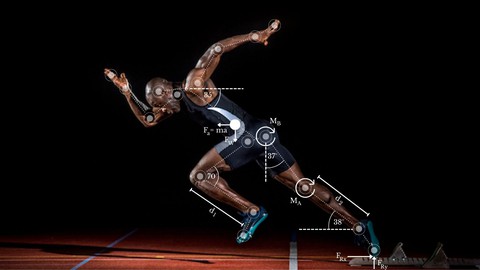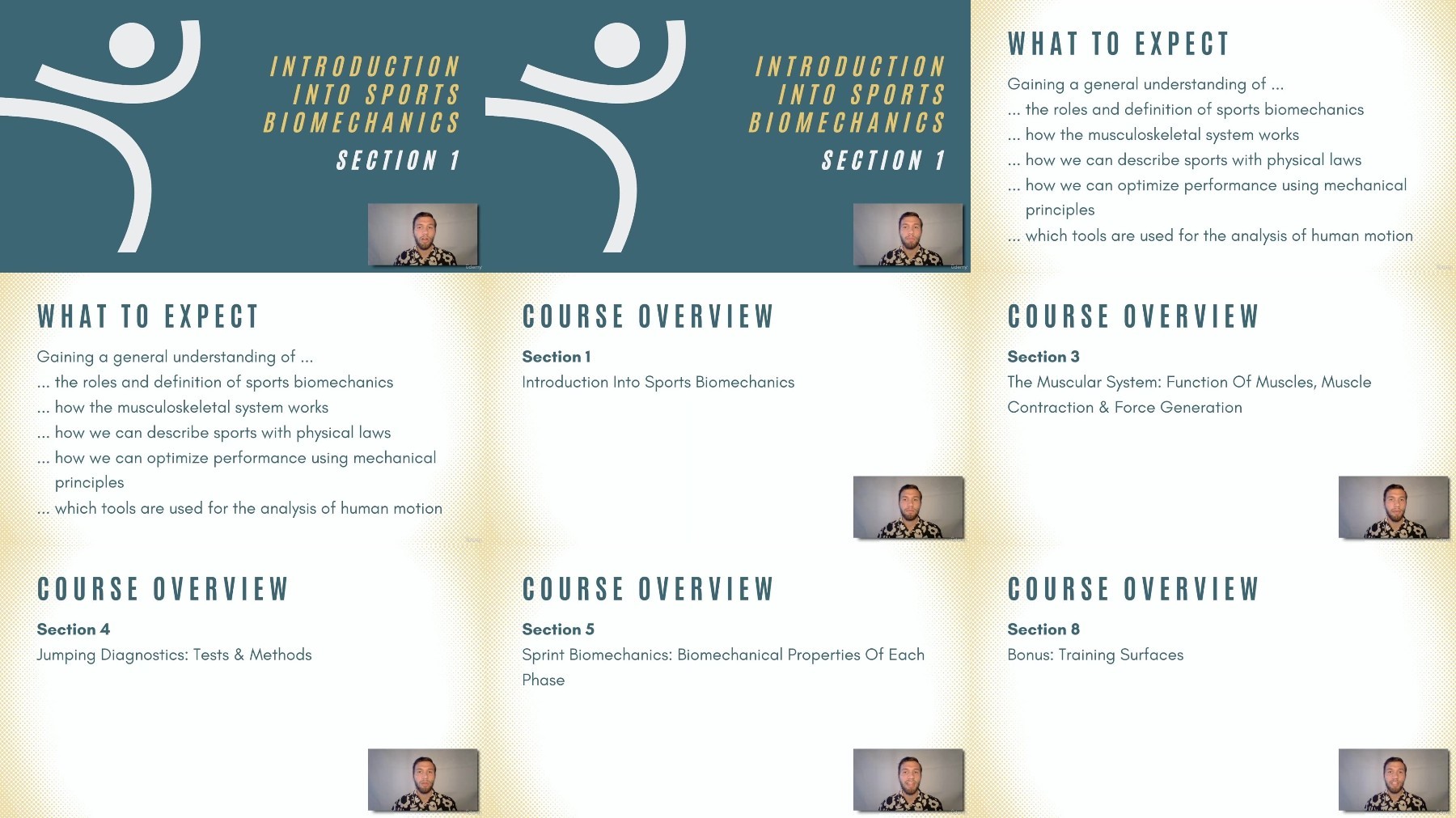Sports Biomechanics: Analyze & Optimize Athletic Performance

Sports Biomechanics: Analyze & Optimize Athletic Performance
Published 3/2024
MP4 | Video: h264, 1920x1080 | Audio: AAC, 44.1 KHz
Language: English
| Size: 1.85 GB[/center]
| Duration: 3h 30m
Understand The Physics Of Sports: The Diagnostics Of Athleticism, The Musculoskeletal System, Motion Analysis & More
What you'll learn
Learn which methods and diagnostics are used to measure an athlete's performance
Understand how the muscular system works
Get to know the tasks and the fields of work for sports biomechanics
Learn about the structure and functioning of the skeletal system
Understand the biomechanics that allow the best technique for sprinting
Get to know the most essential tools that are used for motion analysis in the industry
Understand how the non-contractile components of the body contribute to an increased performance
Learn how we generate force
Understand the effect of training surfaces and shoes on athletic performance
Get to know the biomechanical principles that describe the physics of all movements
Requirements
No prior knowledge needed
Description
GET TO KNOW THE BIOMECHANICS OF SPORTS TO UNDERSTAND, ANALYZE AND OPTIMIZE ATHLETIC PERFORMANCE!In this course, we go deep into the science of human movement in order to understand the biomechanics of sports. The goal is to break down motion into its physics in order to analyze and optimize athletic performance.For that, we first need to understand the anatomy and physiology of the musculoskeletal system. Then, we use different tests, methods and principles to capture the diagnostics and the biomechanics of different movements in sports. Ultimately, with all the prior knowledge that we have gained, we look at the most common tools and devices that are used in the industry for motion analysis.If You Are Curious And Want To Pursue A Career In Biomechanics, Check Out This Course.As a studied biomechanist myself, I study the science of human locomotion and find ways to analyze and optimize movements. This course contains lots of valuable scientifically proven knowledge that I have gained over the years studying and working in the field of biomechanics, put together into 60+ lectures and 3.5 hours of content. Let me share it with you!After finishing this course, you will be able to:Understand the anatomy and the function of the skeletal systemUnderstand structure of the muscular system and the functioning of muscle contractionKnow how to break down movements into its physical propertiesApply different methods to different vertical jump tests to calculate the jump heightUnderstand the biomechanics of sprintingKnow the most common tools used for motion analysis in the industryThe following topics will be covered in this course:Introduction Into Sports BiomechanicsHow can we define sports biomechanics?What are the tasks and what are some possible fields of work for sports biomechanics?Which terms are used in the biomechanics to describe locations and movements?The Skeletal SystemWhat's the structure of bones and joints?What does "stress shielding" mean and why is it bad?What's the structure and function of tendons and ligaments?The Muscular SystemWhich types of muscle are there and how are they built?How do muscles contract and how does it affect force generation?How do muscles and tendons work together to ensure optimal elasticity?Jumping DiagnosticsWhat are the goals of jumping diagnostics?Which different jump tests are there and when should they be used?Which methods are there to calculate different performance parameters like the jump height?Sprint BiomechanicsIn which biomechanical phases can we devide a 100 m sprint?What are the differences in the technique and the biomechanics in each phase?What are the effects of supporting systems (shoes, prostheses etc.) on the sprint performance?Biomechanical PrinciplesHow can we use physics to describe movements in sports?Why do we have the biomechanical principles and how can they help us to understand motion?What are the characteristics of each biomechanical principle?Motion AnalysisWhat are the objectives of motion tracking?Which tools for the analysis of human movement exist in the industry?How can we further analyze data obtained from motion tracking systems?Training SurfacesWhat are the effects of footwear constructions on athletic performance?What are the effects of training surfaces on athletic performance?What are the biomechanical and performance benefits of training barefoot?Of course, there is a 30-day money-back guarantee from Udemy. Feel free to enroll now to see if this course is for you!
Overview
Section 1: Introduction Into Sports Biomechanics
Lecture 1 Welcome To The Course!
Lecture 2 Course Structure & Overview
Lecture 3 Definition Of Sports Biomechanics
Lecture 4 Planes & Axes
Lecture 5 Location & Movement Terminology
Section 2: The Skeletal System: Bones, Joints, Tendons & Ligaments
Lecture 6 Structure & Function Of Bones
Lecture 7 Bone Types
Lecture 8 Stress Shielding
Lecture 9 Anatomy & Functioning Of Joints
Lecture 10 Joint Types
Lecture 11 Anatomy Of The Knee Joint
Lecture 12 Structure & Function Of Tendons & Ligaments
Lecture 13 Ligaments Of The Knee Joint
Lecture 14 Meniscus
Section 3: The Muscular System: Function Of Muscles, Muscle Contraction & Force Generation
Lecture 15 Muscle Types
Lecture 16 Structure Of Skeletal Muscle
Lecture 17 Muscle Contraction
Lecture 18 Quick Reminder!
Lecture 19 Force-Length Relationship
Lecture 20 Muscle Fiber Types
Lecture 21 Muscle Architectures
Lecture 22 Forms Of Muscle Contraction
Lecture 23 Force-Velocity Relationship
Lecture 24 Stretch Shortening Cycle
Lecture 25 Cocontraction
Lecture 26 Muscle Hypertrophy
Section 4: Jumping Diagnostics: Tests & Methods
Lecture 27 Goals Of Jumping Diagnostics
Lecture 28 Squat Jump Test
Lecture 29 Countermovement Jump Test
Lecture 30 Drop Jump Test
Lecture 31 Impulse Method
Lecture 32 Integration Method
Lecture 33 Time-Of-Flight Method
Section 5: Sprint Biomechanics: Biomechanical Properties Of Each Phase
Lecture 34 Initial Phase
Lecture 35 Acceleration Phase
Lecture 36 Maximal Velocity Phase
Lecture 37 Force Generating Components
Lecture 38 Energy Storage & Release
Lecture 39 Effects Of Shoes On Sprinting
Section 6: Biomechanical Principles: Breaking Down Movements & Sports
Lecture 40 Definition Of The Biomechanical Principles
Lecture 41 Principle Of The Optimal Acceleration Path
Lecture 42 Velocity-Time Curve
Lecture 43 Principle Of The Optimal Tendency In The Acceleration Curve
Lecture 44 Principle Of Initial Force
Lecture 45 Principle Of (Temporal) Coordination Of Individual Impulses
Lecture 46 Principle Of Counteraction And Rotational Recoil
Lecture 47 Principle Of Momentum Conservation
Section 7: Motion Analysis: Tools & Strategies
Lecture 48 Motion Tracking: Objectives
Lecture 49 Inertial Measurement Unit (IMU)
Lecture 50 Force & Pressure Plates
Lecture 51 2D Motion Analysis
Lecture 52 3D Motion Analysis
Lecture 53 Data Analysis
Lecture 54 Thank You!
Section 8: Training Surfaces
Lecture 55 Effects Of Footwear Constructions On Performance
Lecture 56 Effects Of The Training Surface
Lecture 57 Training In Sand
Lecture 58 Barefoot Training
Lecture 59 Trampolin Training
Section 9: Additional Content
Lecture 60 Location & Movement Terminology
Lecture 61 Joint & Bone Types
Lecture 62 Muscle Map
Lecture 63 Bone Map
Anyone who is interested in the biomechanics of sports,Athletes, trainers and coaches who want to learn more about the science of movement


https://rapidgator.net/file/188322715fc7b5e8c2d00b209dd2143d/
https://rapidgator.net/file/c8ed9df7cec479cf37aa7d6ee2fbeb34/


Sports Biomechanics Analyze & Optimize Athletic Performance
